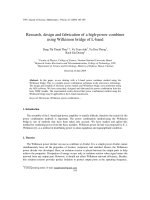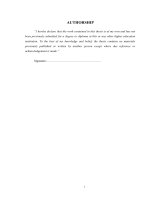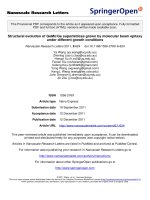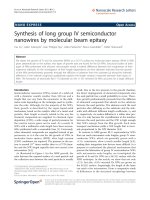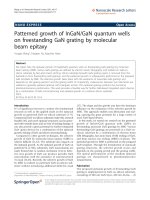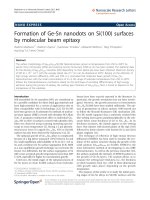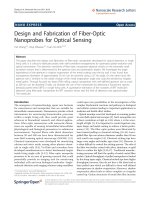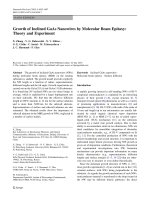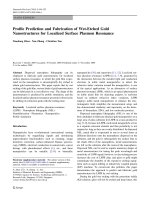Design and fabrication of III v semiconductor nanostructures by molecular beam epitaxy
Bạn đang xem bản rút gọn của tài liệu. Xem và tải ngay bản đầy đủ của tài liệu tại đây (23.96 MB, 149 trang )
DESIGN AND FABRICATION OF III-V
SEMICONDUCTOR NANOSTRUCTURES BY
MOLECULAR BEAM EPITAXY
TUNG KAR HOO PATRICK
(B.Eng. (Hons.), NUS)
A THESIS SUBMITTED
FOR THE DEGREE OF DOCTOR OF PHILOSOPHY
DEPARTMENT OF ELECTRICAL & COMPUTER
ENGINEERING
NATIONAL UNIVERSITY OF SINGAPORE
2014
Declaration
I hereby declare that this thesis is my original work and it has been
written by me in its entirety. I have duly acknowledged all the sources of
information which have been used in the thesis.
This thesis has also not been submitted for any degree in any university
previously.
Tung Kar Hoo Patrick
19 August 2014
Acknowledgements
I know it would be impossible to express my thanks to everyone who has
supported me and made me come so far. I will try my best attempt to express my heartfelt thanks in the following. Firstly, I am grateful to NUS in
supporting me with a President Graduate Fellowship to pursue my PhD at
NUS. I would like to express my sincere gratitude to my current supervisor,
Associate Professor Dr Aaron Danner for his supervision, helpful guidance
and stimulating suggestions during the course of the project. He holds a
triple role model for me, as a teacher, as an advisor and as a friend. Dr
Aaron Danner sets a gold standard that I will always want to achieve. I
was very fortunate to attend one of the most inspiring classes taught by
him when I was an undergraduate at NUS, EE3407, Analog Electronics. I
have been truly lucky to be able to learn from one so wise in physics.
In the course of my PhD, I would also want to express gratitude to my
ex-supervisor, Dr Xiang Ning. As a mentor, she has shown me her dedication in her teaching which led me to experience that teaching is actually
the highest form of learning. As a friend, she gave me advice on how to
deal with life adversities. Thank you for putting up with all my complaints
from a typical Singaporean!
I would also like to thank my group mates, Ms Gao Hongwei and Mr
i
Huang Jian for their assistance in sample fabrication and all the other PhD
students from the Centre for Optoelectronics (COE). You have supported
me in one way or the other. In addition, I would like to express my appreciation to Mr Wee Qixun who taught me how to use the COE equipment
and to Mr Mridul Sakhuja who has been cheering me on all the time. Last
but not least, the staff of COE, laboratory officers Mr Tan Beng Hwee, Mr
Rayson Tan and Ms Musni bte Hussain, for their assistance given during
the course of the project.
Finally, my heartfelt appreciation goes to the most important people in
my life, my family and my girlfriend, Wan Ru, for listening to my problems
and giving me encouraging words of wisdom as I went through this difficult
time. Their love and support has allowed me to finish this.
ii
Contents
Acknowledgements
i
Summary
vii
List of Tables
ix
List of Figures
x
List of Abbreviations and Symbols
1 Introduction
1.1
1.2
xv
1
III-V semiconductors . . . . . . . . . . . . . . . . . . . . . .
1
1.1.1
Properties of GaAs . . . . . . . . . . . . . . . . . . .
2
1.1.2
GaAs based devices . . . . . . . . . . . . . . . . . . .
4
Semiconductor nanostructures . . . . . . . . . . . . . . . . .
6
1.2.1
Quantum dots . . . . . . . . . . . . . . . . . . . . . .
6
1.2.2
Quantum rings . . . . . . . . . . . . . . . . . . . . .
9
1.3
PL emission from nanostructures . . . . . . . . . . . . . . . 10
1.4
Templated semiconductor nanofabrication . . . . . . . . . . 13
1.5
Applications of nanofabrication . . . . . . . . . . . . . . . . 16
1.5.1
QDs in light emitting diodes . . . . . . . . . . . . . . 16
1.5.2
QDs in lasers . . . . . . . . . . . . . . . . . . . . . . 16
1.5.3
Possible QR applications . . . . . . . . . . . . . . . . 18
iii
1.6
Motivation and objective of the thesis . . . . . . . . . . . . . 19
1.7
Thesis organisation . . . . . . . . . . . . . . . . . . . . . . . 19
1.8
Key contributions of the thesis . . . . . . . . . . . . . . . . . 21
2 Background knowledge and general experimental techniques 22
2.1
Overview . . . . . . . . . . . . . . . . . . . . . . . . . . . . . 22
2.2
Molecular beam epitaxy . . . . . . . . . . . . . . . . . . . . 23
2.2.1
Droplet epitaxy . . . . . . . . . . . . . . . . . . . . . 30
2.2.2
Migration enhanced epitaxy . . . . . . . . . . . . . . 33
2.3
Electron beam deposition
2.4
Laser interference lithography . . . . . . . . . . . . . . . . . 36
2.4.1
2.5
. . . . . . . . . . . . . . . . . . . 34
Template transfer process using LIL . . . . . . . . . . 37
Anodic aluminium oxide template . . . . . . . . . . . . . . . 40
2.5.1
AAO formation principle . . . . . . . . . . . . . . . . 40
2.5.2
Two-step anodisation . . . . . . . . . . . . . . . . . . 42
2.5.3
Fabrication of AAO fabrication from Al foil . . . . . 43
2.5.4
Fabrication of AAO fabrication from Al thin film . . 44
2.5.5
Comparison of two AAO fabrication methods . . . . 45
2.5.6
AAO template transfer by wafer bonding . . . . . . . 46
3 Characterisation methods
49
3.1
Photoluminescence . . . . . . . . . . . . . . . . . . . . . . . 49
3.2
Scanning electron microscopy . . . . . . . . . . . . . . . . . 52
3.2.1
Energy dispersive X-ray spectrometry . . . . . . . . . 54
3.3
Atomic force microscopy . . . . . . . . . . . . . . . . . . . . 55
3.4
X-ray diffraction . . . . . . . . . . . . . . . . . . . . . . . . 56
3.5
Transmission electron microscopy . . . . . . . . . . . . . . . 58
4 Growth of self-assembled GaAs quantum rings on AlGaAs/GaAs
(001) by droplet epitaxy
61
iv
4.1
Introduction . . . . . . . . . . . . . . . . . . . . . . . . . . . 62
4.2
Growth of GaAs QRs using DE . . . . . . . . . . . . . . . . 62
4.3
4.4
4.2.1
Buffer layer growth . . . . . . . . . . . . . . . . . . . 62
4.2.2
Effect of amount of Ga in QR formation . . . . . . . 63
4.2.3
Effect of arsenisation temperature in QR formation . 64
4.2.4
Optimised GaAs QR formation . . . . . . . . . . . . 65
Results and discussion . . . . . . . . . . . . . . . . . . . . . 67
4.3.1
Effect of arsenisation time in QR formation . . . . . 68
4.3.2
PL investigation of capped GaAs QRs . . . . . . . . 71
Summary . . . . . . . . . . . . . . . . . . . . . . . . . . . . 76
5 Growth of ordered two-dimensional GaAs and InGaAs quantum rings on GaAs (001) by droplet epitaxy
78
5.1
Introduction . . . . . . . . . . . . . . . . . . . . . . . . . . . 79
5.2
Experimental process . . . . . . . . . . . . . . . . . . . . . . 80
5.3
5.4
5.2.1
GaAs buffer growth . . . . . . . . . . . . . . . . . . . 80
5.2.2
Self-assembled QRs growth . . . . . . . . . . . . . . . 80
5.2.3
Ordered QRs growth . . . . . . . . . . . . . . . . . . 81
5.2.4
Surface passivation: As capping and decapping
5.2.5
Template fabrication . . . . . . . . . . . . . . . . . . 82
5.2.6
Improved lift-off technique . . . . . . . . . . . . . . . 84
5.2.7
MBE regrowth of ordered QRs . . . . . . . . . . . . . 88
. . . 81
Results and discussion . . . . . . . . . . . . . . . . . . . . . 89
5.3.1
Self-assembled growth of QRs . . . . . . . . . . . . . 89
5.3.2
SiO2 templated growth of QRs . . . . . . . . . . . . . 92
Summary . . . . . . . . . . . . . . . . . . . . . . . . . . . . 95
6 Growth of ordered InGaAs quantum dots on GaAs (001)
using an AAO template by migration enhanced epitaxy
v
96
6.1
Introduction . . . . . . . . . . . . . . . . . . . . . . . . . . . 97
6.2
Experimental process . . . . . . . . . . . . . . . . . . . . . . 98
6.3
Improved AAO fabrication . . . . . . . . . . . . . . . . . . . 98
6.3.1
Post bonding treatment . . . . . . . . . . . . . . . . 99
6.4
Epitaxial growth of InGaAs QDs with MEE . . . . . . . . . 100
6.5
Results and discussion . . . . . . . . . . . . . . . . . . . . . 102
6.6
Summary . . . . . . . . . . . . . . . . . . . . . . . . . . . . 107
7 Conclusion and future work
108
7.1
Conclusion . . . . . . . . . . . . . . . . . . . . . . . . . . . . 108
7.2
Recommendations for future work . . . . . . . . . . . . . . . 111
7.2.1
Size adjustment of QDs via AAO nanohole size . . . 111
7.2.2
PL enhancement by ordered metal nanoparticle array 111
7.2.3
Novel metal-semiconductor hetero-nanostructures . . 112
Bibliography
113
Appendices
127
A List of publications
128
vi
Summary
Low dimensional structures have revolutionised electronic devices in terms
of their potential and increased efficiency. They can be applied to promising
materials where the electronic properties can be modified to suit different
optoelectronic applications. In recent years, the growth of self-assembled
nanostructures has been intensely studied, both for understanding basic physics and for implementation in device applications. The properties of nanostructures strongly depends on their dimensionality. In threedimensional (3D) nanostructures for example, there are situations in which
only discrete energy states are allowed and the density of states (DOS)
resembles a series of delta functions. The ability to control this density
of states over a very narrow energy range is significant for a variety of
theoretical topics and device applications. The fabrication of 3D nanostructures gained a lot of attention in the 1990s when quantum dots (QDs)
were first demonstrated using lattice mismatched layers in the StranskiKrastanov (SK) growth mode and the droplet epitaxy (DE) fabrication
technique grown by MBE. Self-assembled nanostructures grown by these
two methods generally show very high optical crystal quality suitable for
device applications.
In the course of this work, the fabrication and characterisation of nanostructures using different configurations of epitaxial growth have been investigated. Self-assembled GaAs quantum rings (QRs) were fabricated on an
AlGaAs/GaAs substrate using the DE technique. The mechanism of the
formation of GaAs QRs was investigated indirectly using photoluminescence (PL) spectra. It has been found that GaAs QRs have a bimodal distribution resulting in dual PL peaks. By extending self-assembled growth
of QRs to ordered QRs, laser interference lithography (LIL) was used to
create a template with subsequent transfer to SiO2 . InGaAs and GaAs
vii
QRs were grown using DE with a SiO2 nanohole template. It was observed
that GaAs rings form clusters inside a single SiO2 nanohole compared to
one single InGaAs ring in each SiO2 nanohole. It is proposed that the difference in morphology is a result of different migration speeds of Ga and
In.
LIL requires extensive setup and processing time plus there is a limitation of the feature size it can fabricate. This leads to exploration of
other templating solutions. Non-lithographic self-assembled anodic aluminium oxide (AAO) has been used as a growth template for its ease of
fabrication and template transfer onto substrates of interest. By combining this template and epitaxial growth, different nanostructures can be
realised by subsequent etching of the AAO template. The use of an AAO
template was employed in the growth of ordered InGaAs QDs using the
migration enhanced epitaxy (MEE) technique. Good growth selectivity
was observed by increasing the diffusion lengths of the individual group
III species. These results provide a pathway for fabricating ordered III-V
semiconductor nanostructures which is part of the fabrication work towards
device applications.
viii
List of Tables
2.1
Parameters that govern the shapes of nanostructures. . . . . 33
2.2
Key differences between two AAO fabrication methods. . . . 45
6.1
Growth parameters for samples A, B, C, D and E. . . . . . . 102
ix
List of Figures
1.1
Unit cell of GaAs. . . . . . . . . . . . . . . . . . . . . . . . .
2
1.2
Band structure of GaAs [2]. . . . . . . . . . . . . . . . . . .
3
1.3
Plot of bandgap against lattice constant of various III-V
semiconductors [8]. Reproduced with permission. . . . . . . .
1.4
5
Schematic diagram showing possible heterostructure film growth.
(a) Identical lattice matching, (b) Dislocations arising from
lattice mismatched film and (c) Strained film from a lattice
mismatched film, t ≤ tc . . . . . . . . . . . . . . . . . . . . .
1.5
6
Schematic morphology (left) and density of states (right)
for charge carriers in semiconductor structures with different
dimensionalities: (a) bulk, (b) quantum well, (c) quantum
wire, and (d) quantum dot [10]. Reproduced with permission.
1.6
7
Schematic of SK growth mode with a wetting layer and a 3D
island. . . . . . . . . . . . . . . . . . . . . . . . . . . . . . .
8
1.7
Schematic of DE growth mode using GaAs as an example. .
9
1.8
Schematic illustration of the kinetic diffusion of Ga and trapped
As atoms. . . . . . . . . . . . . . . . . . . . . . . . . . . . . 11
1.9
Schematic illustration of the (a) photo-excitation process
and (b) the recombination process. . . . . . . . . . . . . . . 12
x
1.10 Schematic illustration of (a) block copolymer lithography
and (b) an SEM image of the fabricated mask [31]. Reproduced with permission. . . . . . . . . . . . . . . . . . . . 14
1.11 Schematic illustration of the process of nanosphere lithography [34]. Reproduced with permission. . . . . . . . . . . . . . 15
1.12 (a) Schematic of QD LED device heterostructure (b) Top
view SEM of surface emitting device with single defect photonic crystal in the center of the aperture and cross-sectional
SEM of single defect photonic crystal after e-beam patterning [39]. Reproduced with permission. . . . . . . . . . . . . . 17
1.13 Schematic of a QD VCSEL. . . . . . . . . . . . . . . . . . . 18
2.1
Photo of Riber MBE 32P system in NUS. . . . . . . . . . . 24
2.2
Schematic drawing of an MBE growth chamber. . . . . . . . 26
2.3
Illustration of Ewald construction. . . . . . . . . . . . . . . . 27
2.4
RHEED image showing a streaky pattern indicating oxide
was fully desorbed. . . . . . . . . . . . . . . . . . . . . . . . 29
2.5
Schematic of RHEED oscillation corresponding to the different stages of formation of one monolayer [54]. Reproduced
with permission. . . . . . . . . . . . . . . . . . . . . . . . . . 30
2.6
Schematic of DE process forming two possible nanostructures using different As flux. . . . . . . . . . . . . . . . . . . 33
2.7
Time evolution of Ga and As flux in a MEE growth.
. . . . 34
2.8
Schematic of an e-beam deposition system . . . . . . . . . . 35
2.9
Schematic of the LIL setup. . . . . . . . . . . . . . . . . . . 36
2.10 Schematic diagram of patterning process using LIL. . . . . . 38
2.11 SEM image showing an array of SiO2 nanohole fabricated on
GaAs. . . . . . . . . . . . . . . . . . . . . . . . . . . . . . . 38
2.12 Schematic of AAO reaction cell. . . . . . . . . . . . . . . . . 41
xi
2.13 SEM image showing the indentations on the AAO surface
after the removal of AAO from 1st anodisation. . . . . . . . 44
2.14 Schematic representation of thin film AAO fabrication on an
Al film.
. . . . . . . . . . . . . . . . . . . . . . . . . . . . . 45
2.15 SEM images of AAO fabricated by different methods. . . . . 46
2.16 Illustration of wafer bonding process (a) After wax application to AAO film (b) After Al etching (c) After barrier layer
etching (d) After bonding to the substrate. . . . . . . . . . . 48
2.17 SEM image showing AAO bonded to the substrate after wax
removal. . . . . . . . . . . . . . . . . . . . . . . . . . . . . . 48
3.1
Radiative recombination processes. (a) band-to-band transition, (b) free electron-to-acceptor transition, (c) free holeto-donor transition, and (d) donor-acceptor pair transition.
EV is the valence band, EC is the conduction band, EA is the
acceptor binding energy and ED is the donor binding energy. 50
3.2
Schematic of a PL setup. . . . . . . . . . . . . . . . . . . . . 51
3.3
A PL map of a quarter 2” GaAs wafer. . . . . . . . . . . . . 52
3.4
Schematic setup of an SEM machine [66]. Reproduced with
permission. . . . . . . . . . . . . . . . . . . . . . . . . . . . 53
3.5
Different emissions from a sample when bombarded by an
electron beam. . . . . . . . . . . . . . . . . . . . . . . . . . . 54
3.6
SEM image of an AFM tip [67]. Reproduced with permission. 56
3.7
Schematic of an AFM machine [67]. Reproduced with permission. . . . . . . . . . . . . . . . . . . . . . . . . . . . . . 57
3.8
Schematic of an XRD machine. . . . . . . . . . . . . . . . . 57
3.9
X-rays impinging on the sample surface. . . . . . . . . . . . 58
3.10 Schematic of a TEM machine [68]. Reproduced with permission. . . . . . . . . . . . . . . . . . . . . . . . . . . . . . . . 59
xii
4.1
SEM images of GaAs QR with different amounts of Ga. (a)
2.5 ML, (b) 5 ML, (c) 10.5 ML and (d) 21 ML. . . . . . . . 64
4.2
SEM images of GaAs QR structures with arsenisation temperature at (a) 150 ◦ C and (b) 300 ◦ C. . . . . . . . . . . . . 66
4.3
Two sets of GaAs QRs for (a) SEM and AFM characterisation and (b) PL characterisation. . . . . . . . . . . . . . . . 68
4.4
SEM images of GaAs QRs (a) Ga droplets, (b) 20 s arsenisation, (c) 60 s arsenisation, and (d) 600 s arsenisation. . . . 69
4.5
AFM images of GaAs QRs (a) Ga droplets, (b) 20 s arsenisation, (c) 60 s arsenisation, and (d) 600 s arsenisation. The
letters “L” and “S” are explained in section 4.3.2. . . . . . . 71
4.6
AFM height analysis of GaAs QRs with 60 s arsenisation.
4.7
Low temperature PL spectra showing different arsenisation
. 72
time (a) 20 s arsenisation, (b) 60 s arsenisation, (c) 600 s
arsenisation, and (d) control sample. . . . . . . . . . . . . . 75
4.7
Low temperature PL spectra showing different arsenisation
time (a) 20 s arsenisation, (b) 60 s arsenisation, (c) 600 s
arsenisation, and (d) control sample. . . . . . . . . . . . . . 76
5.1
SEM image of resist pillars. . . . . . . . . . . . . . . . . . . 83
5.2
SEM image of lift-off after immersion in S1165 for 8 hr. . . . 84
5.3
SEM image of lift-off after immersion it in S1165 for 8 hr
followed by 15 min ultrasonic agitation. . . . . . . . . . . . . 85
5.4
Illustrations of the samples; (a) before lift-off and two different lift-off processes using (b) dipping method and (c)
airbrush jetting method. . . . . . . . . . . . . . . . . . . . . 87
5.5
SEM image of lift-off after spraying the sample using airbrush. 88
5.6
EDX graph with inset showing SEM image of SiO2 template. 88
5.7
SEM image of GaAs QRs grown by DE. . . . . . . . . . . . 90
xiii
5.8
SEM image of InGaAs QRs grown by DE. . . . . . . . . . . 91
5.9
SEM image of GaAs QRs grown by DE on SiO2 template. . 93
5.10 SEM image of InGaAs QRs grown by DE on SiO2 template.
6.1
94
SEM image of ultrathin AAO (∼80 nm) bonded to GaAs
substrate. . . . . . . . . . . . . . . . . . . . . . . . . . . . . 100
6.2
MEE timing diagram showing one cycle of the source opening sequence. . . . . . . . . . . . . . . . . . . . . . . . . . . 101
6.3
A comparison of AAO template after growth using (a) conventional MBE, (b) MEE with tbGa 10 s and (c) MEE with
tbGa 15 s. . . . . . . . . . . . . . . . . . . . . . . . . . . . . . 103
6.4
SEM image of InGaAs QD with inset showing orientation
relation between pyramidal facets with substrate. . . . . . . 104
6.5
HRTEM images of one QD from sample C with (a) showing
one corner of the QD (b) Higher resolution image of small
square area highlighted in (a) with inset showing electron
diffraction pattern of the QD. . . . . . . . . . . . . . . . . . 105
6.6
XRD curve of sample D, 50 nm thick InGaAs grown by MEE
at 530 ◦ C with inset showing the rocking curve of InGaAs
layer. . . . . . . . . . . . . . . . . . . . . . . . . . . . . . . . 106
6.7
XRD curve of sample E, 50 nm thick InGaAs grown by MEE
at 500 ◦ C. . . . . . . . . . . . . . . . . . . . . . . . . . . . . 106
7.1
SEM image showing AAO film and Ag nanoparticles after
20 nm Ag deposition. . . . . . . . . . . . . . . . . . . . . . . 112
xiv
List of Abbreviations and
Symbols
AAO
Anodic aluminium oxide
AFM
Atomic force microscope
Ag
Silver
Al
Aluminium
AlGaAs
Aluminium gallium arsenide
Au
Gold
BEP
Beam equivalent pressure
CW
Continuous wave
DE
Droplet epitaxy
GaAs
Gallium arsenide
InGaAs
Indium gallium arsenide
LED
Light emitting diode
LIL
Laser interference lithography
MBE
Molecular beam epitaxy
xv
MEE
Migration enhanced epitaxy
Ni
Nickel
NUS
National University of Singapore
PL
Photoluminescence
QD
Quantum dot
QR
Quantum ring
QW
Quantum well
RHEED
Reflection high energy electron diffraction
RIE
Reactive ion etching
SEM
Scanning electron microscope
SP
Surface plasmon
TEM
Transmission electron microscope
VCSEL
Vertical cavity surface emitting laser
XRD
X-ray diffraction
xvi
Chapter 1
Introduction
This chapter briefly touches on the history of III-V semiconductor compounds and their applications in semiconductors electronics. This is followed by the introduction of the material properties of GaAs and the
physics of nanostructures. The applications of GaAs based nanostructures
will be discussed together with their integration with current nanofabrication techniques. The chapter concludes with an outcome of the thesis
organisation and the key contributions of this thesis.
1.1
III-V semiconductors
Semiconductor device development took the stage with the discovery of
the transistor in 1947 by John Bardeen, Walter Brattain, and William
Shockley [1]. This spurred interest in semiconductor research in many
areas, one of which was to find a better material than Si. Gallium Arsenide,
GaAs, for example, is a superior material to Si in terms electronic and
optical properties. Since the recognition of GaAs superiority, it took several
decades before the availability of commercial GaAs devices in the 1970s.
Besides material development, advancement in fabrication techniques has
led to a progressive reduction in dimensionality of materials, starting from
1
bulk GaAs to quantum wells (QWs), quantum wires and then to quantum
dots (QDs).
1.1.1
Properties of GaAs
GaAs is a III-V compound semiconductor with a substituted diamond lattice known as a zinc blende structure. The atomic arrangement in a unit
cell is shown in figure 1.1. GaAs has a lattice constant of a = 5.653 ˚
A. The
electronic band structure of GaAs is shown in figure 1.2. From the band
structure, the smallest bandgap between the valence band and conduction
band occurs at the Γ point making it a direct bandgap semiconductor.
The reason for studying GaAs based III-V semiconductor is because of
its superior intrinsic electronic and optical properties. These advantages
include:
Figure 1.1: Unit cell of GaAs.
2
Figure 1.2: Band structure of GaAs [2].
1. High electron mobility
2. High electron drift velocity
3. Thermally stable semi-insulating substrates
4. Ability to form a variety of heterojunctions with other III-V materials
GaAs has approximately 6× higher electron mobility compared to Si
and semi-insulating GaAs substrates are intrinsically stable at high temperatures to cope with heat generation in high speed devices. Lastly and
most importantly, GaAs can be lattice engineered with a variety of materials such as Indium (In), Aluminium (Al), Phosphorous (P) producing
InGaAs/GaAs, AlGaAs/GaAs, InGaP/GaAs, etc. [3]. The ability to alloy
III-V semiconductors is a very important advantage because the properties
of III-V compounds can be tuned precisely to meet a device’s requirements.
3
For instance, the addition of Al and In to GaAs can increase or decrease
the bandgap, respectively. This allows optical emission from GaAs to be
tuned for different purposes in optoelectronics such as different emission
wavelengths in light emitting diodes (LEDs) and lasers.
1.1.2
GaAs based devices
GaAs devices are found mainly in electronic devices, light-based photonic
devices or a combination of optoeletronic devices. A prime example of
GaAs based electronic devices are power amplifiers by Apple, currently
used in their flagship iPhone 5 mobile phones. In the arena of photonic devices, GaAs is a direct bandgap material, so light emission by spontaneous
emission or stimulated emission is possible. GaAs lasers were invented in
1962 [4] which led to intense research and development of the light emitting
properties of GaAs. GaAs then gained new importance which ultimately
led it to becoming a material of large commercial value. GaAs based lasers
made their way into one of the most important devices in music history,
the compact disc (CD) audio player. The audio CD which uses a 780 nm
wavelength GaAs laser has penetrated into almost every household around
the globe. As mentioned earlier in point 4 of GaAs advantages, GaAs can
be alloyed with other elements to create ternary and quaternary elements
to customise the bandgap while maintaining a high degree of lattice matching with the substrate material. Figure 1.3 shows a plot of bandgap versus
the lattice constant of common III-V semiconductor materials. This provides designers with a degree of freedom in the types and combinations of
materials that can be used to configure the devices needed. An example
would be in the case of optical interconnect applications. Optical fiber has
only three wavelength windows of lowest attenuation, viz. 0.85 µm, 1.3
µm and 1.55 µm. III-V semiconductor lasers using InGaAsP as an active
4
Figure 1.3: Plot of bandgap against lattice constant of various III-V semiconductors [8]. Reproduced with permission.
material that lase at 1550 nm are employed in fiber-optic telecommunications to take advantage of one of the three windows. This is in comparison
to Si, which is an indirect bandgap material and with low mobility faces
tremendous challenges in realizing photonic devices. Although there have
been efforts in realizing Si-based light emitters such as Si Raman lasers
[5], achieving room temperature continuous lasing still requires significant
advancement to reach the current performance level achievable with III-V
semiconductor compounds [6, 7].
As a downside, GaAs is a compound semiconductor and the cost of
refining the material is higher than that of elemental counterparts. Thus,
GaAs based electronics finds their niche in small-sized circuits that require
high speed or low power consumption.
In the fabrication of ternary and quaternary compounds, the lattice
constant of the alloy may not match exactly that of the GaAs substrate.
5
